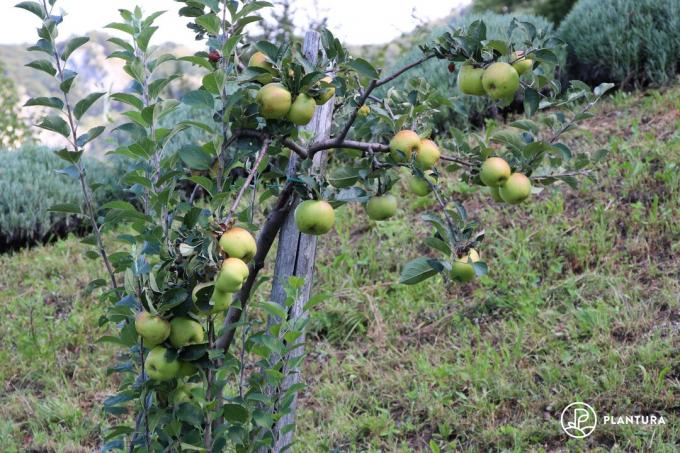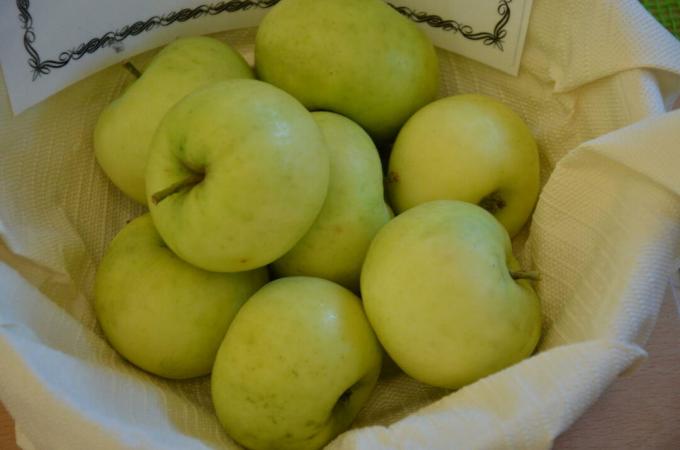The 'White Winter Taffeta Apple' has a shiny white fruit skin and is one of the old varieties. After building up the crown, it requires little care.

The 'White Winter Taffeta Apple' stands out due to its yellowish-white skin. Such old varieties are particularly interesting for allergy sufferers, as they usually cause fewer problems. Due to its low maintenance requirements, the cultivation of the taffeta apple in the right location is relatively easy. If you offer it a sunny, open location on heavy soil, the apple tree, which grows moderately to strongly, will be happy. You can now find out what else there is to know about the old variety 'White Winter Taffeta Apple'.
tip: The reason for the excellent tolerability among allergy sufferers is the often higher content of polyphenols in the old apple varieties. Polyphenols are phytochemicals that make apples taste aromatic but less sweet. In addition, the health-promoting properties of these antioxidant substances have been well researched, including an anti-inflammatory and cancer-preventing effect. The only side effect of the polyphenol, which is unpleasant for some people: the interfaces of the apples turn brown faster than with new varieties.
contents
- ‘White winter taffeta apple’: history and origin
- Taste and characteristics of the apple variety 'White Winter Taffeta Apple'
- Peculiarities in cultivation and care
- Harvesting and use of the winter apple
‘White winter taffeta apple’: history and origin
The exact origin of the 'white winter taffeta apple' is unclear. In the Austro-Hungarian pomology - i.e. in fruit cultivation - there was a report about the 'White Winter Taffeta Apple' as early as 1884: It was then has long been grown in Austria-Hungary, Germany and France and is known as the dessert apple, but would primarily be used as a cider apple used. However, the cultivation did not take place on a large scale. Nowadays, the 'White Winter Taffetapfel' variety can only be found occasionally on meadow orchards and is sold as a table and commercial apple.

tip: The white ‘winter taffeta apple’ is also known under the following synonyms: yellow winter chartreuse, glass apple, chartreuse, silver reinette, Mirror apple, taffeta apple, taffetiner, winter taffeter, wax apple, wax reindeer, white apple, white taffeta apple, white winter taffet and winter taffet.
Taste and characteristics of the apple variety 'White Winter Taffeta Apple'
The 'White Winter Taffeta Apple' tastes juicy, sour and perfumed. The fruits are small to medium-sized. Expressed in dimensions, that means about 4.5 to 5.5 cm high and 6 to 7 cm wide. This results in a flat spherical shape. The basic color of the smooth and waxy skin is yellowish to whitish green, the sun-kissed side rarely shows a washed-out light red top colour. The so-called lenticels, which enable gas exchange and are visible as shell points, have a red border. The core inside the fruit is small, with a closed axis and can therefore be easily separated from the remaining white, fine-celled pulp.
tip: The 'White Winter Taffeta Apple' can easily be confused with the varieties 'Champagne Renette' and 'Late Flowering Taffeta Apple'.

Peculiarities in cultivation and care
The tree makes rather low demands on soil and position. Due to its moderate growth and low maintenance requirements, it is predestined for extensive cultivation on meadow orchards. For this purpose, a medium-growing base and the standard graft are usually chosen. In this way, you can harvest the trees without any major fuss and mow them comfortably underneath. The 'White Winter Taffeta Apple' thrives best in nutritious, clayey soil in a sunny to partially shaded, warm location. In winter, however, the cold and frost don't bother him and the apples hang storm-proof on the tree. A wind-open location is important for this variety, as the flowers tolerate little moisture and typical diseases such as scab, fruit tree canker and powdery mildew can be avoided. For information about the diseases mentioned, see our article Apple Tree Diseases.
On suitable soils, the growth can be quite strong. Growth depends above all on the substrate: This can slow it down or strengthen it. The 'White Winter Taffetapfel' variety itself grows medium to strong. For this reason, the tree should not be made nervous by too radical pruning measures and tempted to sprout too much. In order to harvest high-quality fruit, it is worth cutting the fruiting branches every year to ensure new fruiting wood. Everything you need to know Pruning apple trees we have summarized in a special article.
Expert tip: For an allotment garden, a slow-growing rootstock and grafting as a half-stem or bush tree should be chosen. Nevertheless, give the tree at least 3 x 3 m of standing space so that it can be easily cared for.
The pale wine-red flowers do not appear until mid-May and usually bring regular, medium-high yields. They are self-pollinating and therefore do not necessarily need a pollinator variety in the garden. The yield is increased, among other things, by pollination with the varieties 'Baumanns Renette' 'champagne reinette‘, ‘Cox Orange' or 'gold parmesan‘. The pollen of the 'White Winter Taffeta' itself can of course also fertilize other varieties such as 'Charlamowsky'.
tip: The blossoms are attacked by the apple blossom weevil with above-average frequency. A nesting box in turn attracts birds that eat the apple blossom weevil.

Harvesting and use of the winter apple
The 'White Winter Taffeta Apples' can be picked from mid-October. You should wait until December to eat them, only then are they ready to eat. The apples can be stored in a cool, dark place until March, sometimes even April. Their sensitivity to pressure should be taken into account.
The juicy cells of the pulp are ideal for pressing a sour juice. Direct consumption is also possible.
Have you got a taste for it and now want to plant a 'white winter taffy apple'? Here we explain it to you Apple tree plants in 10 steps.



